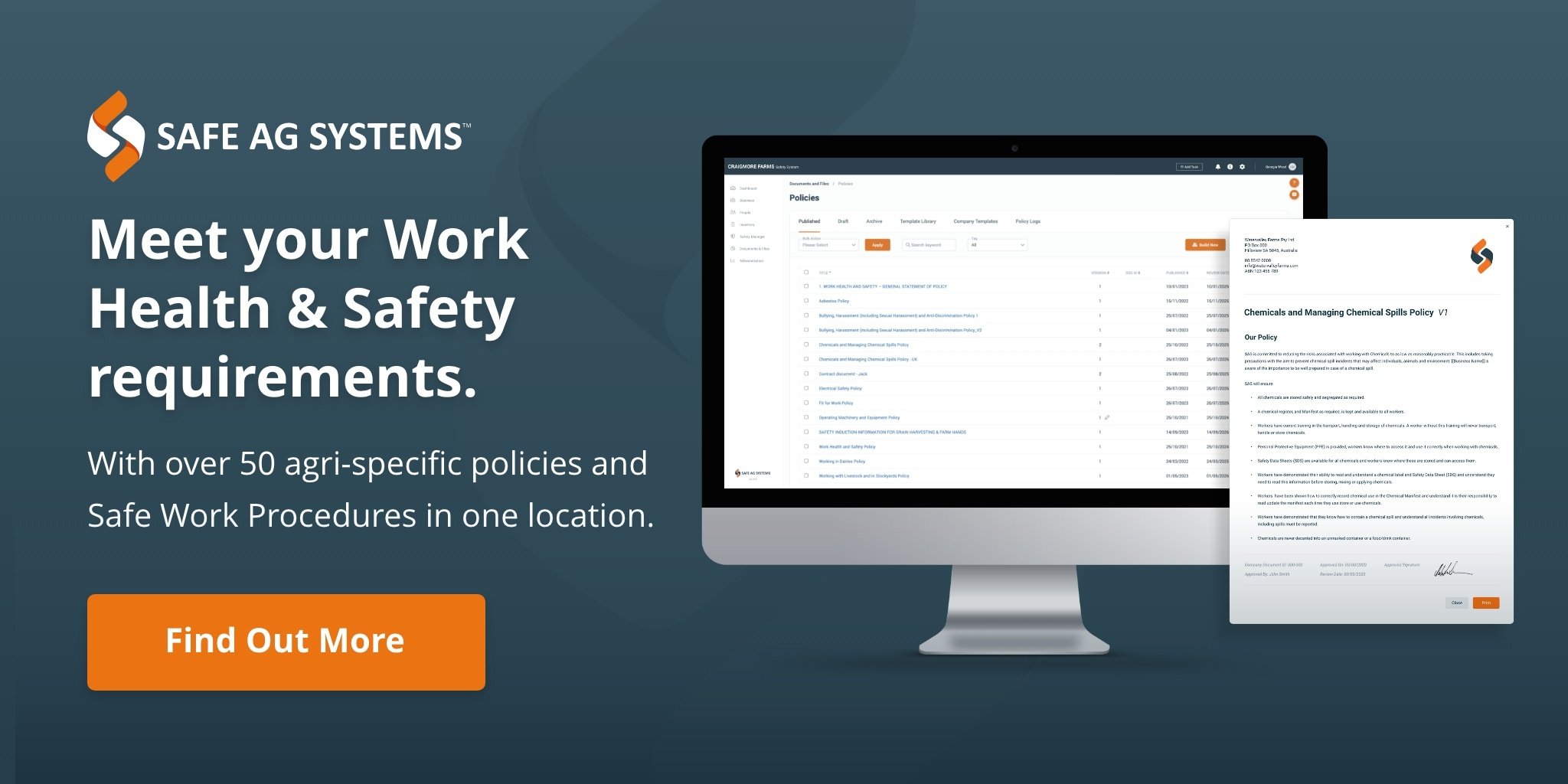You’ve likely engaged with a farm contractor before. They’re a popular agricultural service provider when tasks are too big or complicated for farms to tackle themselves.
Farms often hire contractors for specific jobs or seasonal tasks. These involve planting, spraying, harvesting, picking, shearing, fencing, and any other kind of contractual work.
But before contractors next arrive on your farm, review how you’re managing them and if you’re meeting safety obligations.
Who’s responsible for the health and safety of contractors?
It's important to remember that even though farm contractors aren’t direct employees, you still have a duty of care for their health and safety while engaged with them. The same goes for their workers and any sub-contractors.
Under workplace health and safety (WHS), they are classified as workers, so they have the same safety duties, rights, and protections as your direct workers.
Contractors still have a duty to safety. As a Person Conducting a Business or Undertaking (PCBU), they have their own obligations and responsibilities regarding safety.
But remember, they’re still recognised as a worker while engaged with you. Visit Safe Work Australia’s 'WHS duties in a contractual chain' fact sheet to understand the full depth of the contractual chain.
So how do you manage this shared safety obligation?
Good communication. Consultation. And documenting everything.
Consider who owns the farming equipment the contractor will be using. If it is yours, you're obligated to ensure it is safe to operate and to provide a copy of any Safe Work Procedures you have to the contractor and their workers
You must also ensure they have the correct training or licenses to operate the machinery. Don't assume they know how to operate it just because they have used similar machinery in the past.
If they bring their own tools or equipment then they should have their own procedures for safe use.
Ensure you send them a safety induction before the work begins. They must complete it and share it with any other workers they may have.
This will provide an opportunity to show them key health and safety information such as:
-
Key risks, including tracks to be followed when moving around the farm, overhead powerlines, no-go zones, etc.
-
Emergency management procedures including who to contact, first aiders and emergency wardens
-
Relevant Work health and safety policies and procedures
-
How to report hazards, incidents, near misses and injuries
How to identify a safe farming contractor?
Getting some contractors to recognise safety can be like pulling teeth. They don’t want to hear about it but they're the best in the business, so what do you do?
You can’t force anyone to do anything. It’s the tough truth. But you can try your best to get them to understand. Value your farm safety and communicate it back to them. It only takes one slip-up and you could be liable for their actions.
So how do we identify a safe contractor from a not-so-safe one?
There's no safety badge to identify whether a contracting business has safe working practices. But there are telltale signs to check for.
1. Inquire whether they and their workers have appropriate training
-
Inquire whether their staff have appropriate training for the tasks they’ll be performing, including operating machinery, handling chemicals, and working in hazardous environments.
2. Ask about any previous Incidents
-
A good track record is a good indication that they care about safety and training.
3. Confirm their insurance coverage
-
Ensure they carry adequate insurance, including public liability insurance and workers' compensation. This is critical for protecting both parties in case of an incident.
4. Observe their equipment and practices
-
Keep an eye on their work to ensure their equipment is well-maintained and they are working safely. If they are not speak up.
5. Ask around for references
-
Speak with other farmers who have used their services. They can provide insight into how they behaved on their farm.
6. Conduct a pre-engagement meeting
-
Meet with them to discuss the job and have safety as an agenda item. Their responses and attitude will give you a sense of how they feel about it.
Setting clear safety expectations before the job begins will go a long way in keeping everyone safe.
Contractor management with Safe Ag System.
Make processes easier. Digitise your safety documentation and assign inductions ahead of time. Anywhere, at any time.
Safe Ag Systems is a safety management tool tailored for the agriculture sector. It's designed to help with day-to-day operations and safety responsibilities. The tool covers everything from policies, procedures, and inductions to tasks, inventory, and emergency management.
Better yet, you can manage your contractors with Safe Ag Systems!
Farming contractors can sign up for our online Contractor Directory and you can invite them to connect with your business.
Don’t panic, contractors won’t have complete access to your system. Access will be limited to specific functions that are only available on the App.
Here are a few perks you’ll get by connecting with your contractor on Safe Ag Systems.
-
Assign tasks to keep track of progress
-
Assign policies, procedures and inductions
-
Ability to report near misses or injuries
-
“At Work” function to know when they’re on-site
-
QR codes to access your inventory, such as pre-starts and lock-out/tag-outs.
Making sure your farm contractors are safe and on track doesn’t have to be a hassle. The days of printing out long documents – that nobody actually reads – are long gone!
Streamline your safety obligations to contractors with Safe Ag Systems.
Topics: Safety Management System

Disclaimer: Content on this website may be of relevance to users outside of Australia, but content links and examples are specific to Australia. Please check with your local authority for your country and industry requirements.










